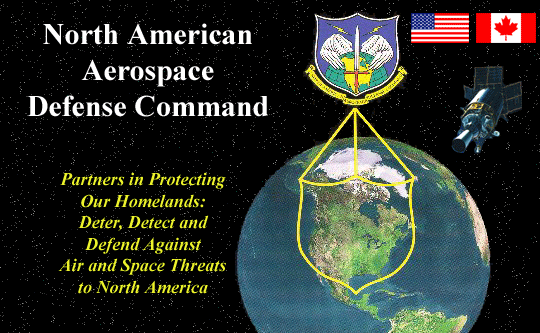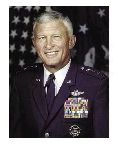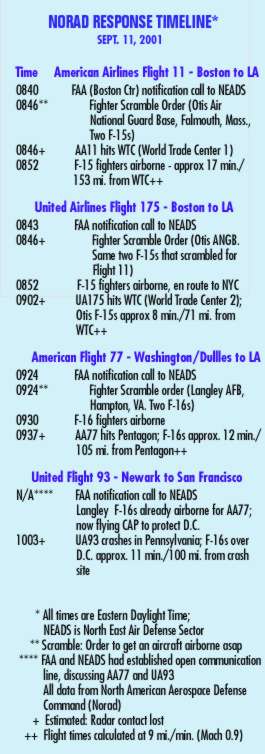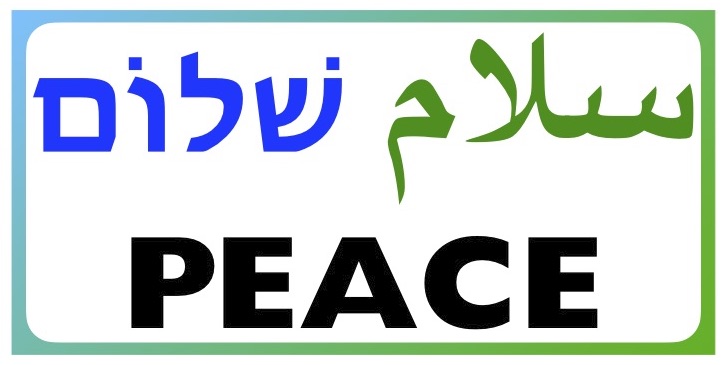 NORAD
NORAD
wargames and the "failure" to defend the skies on 9/11
NORAD's 9/11 wargames
related pages:
- 9/11 wargames
- National Reconnaissance Office
plane into building exercise - 9/11 parable: a wargame analogy
 General Ralph Eberhart, who was in charge of NORAD (air
defense) on 9/11, was the first commander of the new "Northern
Command," the domestic unified military command established in
October 2002. If the domestic use of the U.S. military escalates into
full-scale martial law, the Northern Command
would essentially manage it. If 9/11 had been an "intelligence
failure," it is likely that General Eberhart would have been court-martialed
instead of promoted.
General Ralph Eberhart, who was in charge of NORAD (air
defense) on 9/11, was the first commander of the new "Northern
Command," the domestic unified military command established in
October 2002. If the domestic use of the U.S. military escalates into
full-scale martial law, the Northern Command
would essentially manage it. If 9/11 had been an "intelligence
failure," it is likely that General Eberhart would have been court-martialed
instead of promoted.
Air Force wargames on 9/11
"Vigilant Guardian" NORAD exercise
from "The Failure to Defend the Skies on 911" http://www.unansweredquestions.net/timeline/main/essayairdefense.html
Lt. Col. Dawne Deskins figured it would be a long day.
Sept. 11 was Day II of "Vigilant Guardian," an exercise that would pose an imaginary crisis to North American Air Defense outposts nationwide. The simulation would run all week, and Deskins, starting her 12-hour shift in the Operations Center as the NORAD unit's airborne control and warning officer, might find herself on the spot.
Day I of the simulation had moved slowly. She hoped the exercise gathered steam. It made a long day go faster.
8:40 A.M.: REAL WORLD
In the Ops Center, three rows of radar scopes face a high wall of wide-screen monitors. Supervisors pace behind technicians who peer at the instruments. Here it is always quiet, always dark, except for the green radar glow.
At 8:40, Deskins noticed senior technician Jeremy Powell waving his hand. Boston Center was on the line, he said. It had a hijacked airplane.
"It must be part of the exercise," Deskins thought.
At first, everybody did. Then Deskins saw the glowing direct phone line to the Federal Aviation Administration.
- "Amid Crisis Simulation, 'We Were Suddenly No-Kidding Under Attack'"
by Hart Seely, Newhouse News Service, January 25, 2002
http://www.unansweredquestions.net/timeline/2002/newhousenews012502.html
Aviation Week & Space Technology:
June 3, 2002 Exercise Jump-Starts Response to Attacks
http://www.aviationnow.com/content/publication/awst/20020603/avi_stor.htmAt 8:40 a.m. EDT, Tech. Sgt. Jeremy W. Powell of North American Aerospace Defense Command's (Norad) Northeast Air Defense Sector (NEADS) in Rome, N.Y., took the first call from Boston Center. He notified NEADS commander Col. Robert K. Marr, Jr., of a possible hijacked airliner, American Airlines Flight 11.
"Part of the exercise?" the colonel wondered. No; this is a real-world event, he was told. Several days into a semiannual exercise known as Vigilant Guardian, NEADS was fully staffed, its key officers and enlisted supervisors already manning the operations center "battle cab."
In retrospect, the exercise would prove to be a serendipitous enabler of a rapid military response to terrorist attacks on Sept. 11. Senior officers involved in Vigilant Guardian were manning Norad command centers throughout the U.S. and Canada, available to make immediate decisions.
 The Aviation Week article has a curious aspect -- if
there was a readiness exercise underway, why weren't interceptors deployed
in a timely manner, at least to prevent the attack on the Pentagon (hit nearly an hour and a half after the first plane went off course)?
Aviation Week's "timeline" of 9/11 is extremely deceptive -
it suggests that orders to intercept each plane were only given a few
minutes before each hit their target, omitting the fact that already scrambled
fighters could have intercepted subsequent planes.
The Aviation Week article has a curious aspect -- if
there was a readiness exercise underway, why weren't interceptors deployed
in a timely manner, at least to prevent the attack on the Pentagon (hit nearly an hour and a half after the first plane went off course)?
Aviation Week's "timeline" of 9/11 is extremely deceptive -
it suggests that orders to intercept each plane were only given a few
minutes before each hit their target, omitting the fact that already scrambled
fighters could have intercepted subsequent planes.
"Northern Guardian" and "Northern
Vigilance"
(NORAD exercises on 911/2001)
Copyright 2001 Toronto Star Newspapers, Ltd.
Toronto Star
December 9, 2001 Sunday Ontario Edition
SECTION: BUSINESS; Pg. B05
LENGTH: 974 words
HEADLINE: The scene at NORAD on Sept. 11
BYLINE: Scott Simmie, Toronto Star
Original headline
"Northern Guardian": The Scene at NORAD on Sept. 11
Copyright 2001 Toronto Star Newspapers, Ltd.
Toronto Star
December 9, 2001
Sunday Ontario edition
by Scott SimmieHIGHLIGHT:
Playing Russian war games ... and then someone shouted to look at the monitor
BODY:
EARLY morning, Sept. 11. A lifetime before the attacks on New York and Washington.
Deep inside a mountain in Colorado and far beneath the granite of North Bay, members of the North American Aerospace Defence Command (NORAD) are at full "battle staff" levels for a major annual exercise that tests every facet of the organization.
Operation Northern Vigilance, planned months in advance, involves deploying fighter jets to locations in Alaska and northern Canada. Part of this exercise is pure simulation, but part is real world: NORAD is keeping a close eye on the Russians, who have dispatched long-range bombers to their own high north on a similar exercise.
Everything is going as planned when Capt. Mike Jellinek arrives for his 6 a.m. shift. The Canadian will be overseeing the crew staffing a crucial post inside the mountain - NORAD's command centre.
Whether it's a simulation or a real-world event, the role of the centre is to fuse every critical piece of information NORAD has into a concise and crystalline snapshot.
An hour into his shift, something unscripted happens. NORAD's Northeast Air Defence Sector (NEADS), based in Rome, N.Y., contacts the mountain.
The Federal Aviation Administration has evidence of a hijacking and is asking for NORAD support. This is not part of the exercise.
In a flash, Operation Northern Vigilance is called off. Any simulated information, what's known as an "inject," is purged from the screens.
Someone shouted to look at the monitor displaying CNN.
"At that point, we saw the World Trade Center, one of the towers, smoke coming out of it. And a minute later, we watched the live feed as the second aircraft swung around into the second tower," says Jellinek.note: this assumes that NORAD wasn't contacted for about 40 minutes into the hijacking (second tower hit 9:03 am), which is not believable
He had one question for the people on the line from NEADS: "Was that the hijacked aircraft you were dealing with?" he asked.
Yes, it was, came the reply.
And then, Jellinek says, "it got really, really busy."
Maj.-Gen. Rick Findley, director of NORAD operations, had just completed the night shift. Usually, Findley would be across town at NORAD headquarters at Peterson Air Force Base. But because of the exercise and the time difference with Russia, he'd been working nights in the mountain. He was just preparing to leave when the disaster began unfolding.
It was a scenario unlike any NORAD had trained for.
"Lots of other reports were starting to come in," Findley recalls. "And now you're not too sure. If they're that clever to co-ordinate that kind of attack, what else is taking place across North America? So we were in a very high-tempo mode, trying to stay one step ahead.
"In the face of all this tragedy, people seemed to know what to do. Everyone seemed to understand that there was a crisis that was not well-defined yet."
Orders were quickly given to get more combat aircraft in the sky. Tankers for in-flight refuelling were at the ready.
Combat aircraft were dispatched to escort Air Force One in case the president was at risk. AWAC jets, designed to track air traffic and offer targeting information to combat aircraft, were deployed.
Because no one yet knew who was behind the attack - or what else might be en route - the giant blast doors designed to protect the Cheyenne Mountain Operations Center from a nuclear blast were sealed.
The massive steel slabs, weighing 25 tonnes each, had not been closed in a non-exercise event since the Cold War.
At the Peterson base, staff began covering windows with tape and paper to minimize flying glass should an explosion occur.
The base, NORAD's administrative headquarters, went to a security status known as Threatcon Delta. It's the highest state of alert and had not been in effect since the 1962 Cuban missile crisis.
"It was very eerie here," says Helen Booth, who co-ordinates services for the base's Canadian contingent.
"There was a real sense of crisis."
As that crisis unfolded, NORAD set up a secure line so it could brief key officials and act on their decisions. Jellinek was listening as President George W. Bush made the order to drain the skies of commercial aircraft.
Jellinek, who is close to retirement and doesn't have to "suck up to anyone," says it was one of two courageous decisions made at the very top level.
"The second one was: If it looks like a plane is going to be used as a missile, shoot it down. Again, what a gutsy call. Unprecedented, that we may have to shoot down a civilian airliner to prevent a greater disaster. And that decision was made very quickly."
Another timely decision was made halfway around the world. The Russians, on seeing the attacks in New York and Washington, immediately cancelled their own exercises, turning back their bombers and calling off planned missile testing. The Russians knew NORAD would have its hands full.
"They said: 'Okay, we're pulling back,'" Jellinek says. "They sent the message to the State Department clearly and unambiguously: 'Don't worry about our movements, we're going to stay down for a while.' Very, very useful. Very helpful."
More than three months later, NORAD's heightened tempo and battle-staff levels continue. The challenge will be to decide when, if ever, to scale back.
"Knock on wood, I hope that nothing happens," says Findley, rapping his knuckles on a table.
"But all it will take is one more terrorist event somewhere in the world to reinforce all of that unease again. And how do you back away from what you're doing now if it continues to be a very sporadic conflict?"
Adds Jellinek: "Folks are now having much more serious looks at what are the possible threats to us. What is the right balance of fiscal responsibility, operational responsibility, versus actual threat versus capability?
"It's a complex equation ... but it's one that has been thrust in everyone's face right now."
GRAPHIC: Tom Kimmell FOR THE TORONTO STAR COMMAND CENTRE: Canadian Capt. Mike Jellinek was at the helm in Cheyenne Mountain when two hijacked jets hit the World Trade Center and NORAD "got really, really busy."
www.cnn.com/2004/US/04/19/norad.exercise/index.html
NORAD exercise had jet crashing into building
From Barbara Starr
CNN Washington Bureau
Monday, April 19, 2004 Posted: 7:49 PM EDT (2349 GMT)
NORAD
• Established by: Canada and United States in 1958
• Two missions: Warning and aerospace control
• Motto: Deter, Detect, Defend
• Three regions: Alaskan, Canadian and the continental U.S., which
has three sectors: Western, Northeast and Southeast.
• Headquarters: Peterson AFB, Colorado Springs, Colorado
• Command and Control: Cheyenne Mountain Operations Center in Colorado
WASHINGTON (CNN) -- Sometime between 1991 and 2001, a regional sector of the North American Aerospace Defense Command simulated a foreign hijacked airliner crashing into a building in the United States as part of training exercise scenario, a NORAD spokesman said Monday.
The exercise was solely to test procedures and was no indication that NORAD had any reason to believe the scenario would happen in the real world, according to a spokesman.
It is unclear whether the simulated scenario was that of a hijacked plane being "used as missile" -- intentionally crashing into a building -- or that of an out-of-control hijacked plane.
Military officials said the exercise involved simulating a crash into a building that would be recognizable if identified, but was not the World Trade Center or the Pentagon.
They emphasize it involved an airliner being hijacked as it flew into U.S. airspace from abroad, a slightly different scenario from what happened on September 11, 2001.
The identity of the building named in the exercise is classified.
The exercise was conducted at one regional sector, and was not conducted at the headquarters, as are major exercises. This sector exercise involved some flying of military aircraft as well as a command post exercise in which communications procedures were practiced in an office environment.
NORAD officials emphasized that if it had been a real event, NORAD would have instituted standard procedures to try to contact the aircraft and keep it from crashing.
"We have planned and executed numerous scenarios over the years to include aircraft originating from foreign airports penetrating our sovereign airspace. Regrettably the tragic events of 9/11 were never anticipated or exercised," said Gen. Ralph Eberhart, commander of NORAD.
NORAD has the ongoing mission of defense of U.S. airspace.
According to a statement from NORAD, "Before September 11th, 01, NORAD regularly conducted a variety of exercises that included hijack scenarios. These exercises tested track detection and identification; scramble and interception; hijack procedures; internal and external agency coordination and operational security and communications security procedures."
All of those tasks are the responsibility of NORAD.
The statement continues:
"NORAD did not plan and execute these types of exercises because we thought the scenarios were probable. These exercises were artificial simulations that provided us the opportunity to test and validate our processes and rules of engagement with the appropriate coordination between NORAD's command headquarters, its subordinate regions and sectors and National Command authorities in Canada and the United States.
"Since 9/11 we have continued our exercise program having conducted more than 100 exercises, all of which have included mock hijacks. NORAD has flown 35,000 sorties and scrambled or diverted fighters from air patrols nearly 1,800 times. Additionally, NORAD fighters out of Florida have intercepted two hijacked aircraft since 9/11; both originating from Cuba and escorted to Key West in spring 2003. NORAD remains vigilant and its tolerance for any anomaly in the sky remains very low. The 9/11 commission has been informed about our exercises that include hijack scenarios.
"At the NORAD headquarters' level we normally conducted four major exercises a year, most of which included a hijack scenario. Since 9/11 however we have conducted more than 100 exercises, all of which included at least one hijack scenario."
Monday, April 19, 2004
Air command ran drills similar to Sept. 11 attacks
STEVEN KOMAROW, AND TOM SQUITIERI GANNETT NEWS SERVICE
WASHINGTON -- In the two years before the Sept. 11 attacks, the North American Aerospace Defense Command conducted exercises simulating what the White House says was unimaginable at the time: hijacked airliners used as weapons to crash into targets and cause mass casualties.
One of the imagined targets was the World Trade Center. In another exercise, jets performed a mock shootdown over the Atlantic Ocean of a jet supposedly laden with chemical poisons headed toward a target in the United States. In a third scenario, the target was the Pentagon -- but that drill was not run after defense officials said it was unrealistic, NORAD and Defense officials say.
NORAD, in a written statement, confirmed that such hijacking exercises occurred. It said the scenarios outlined were regional drills, not regularly scheduled continentwide exercises.
"Numerous types of civilian and military aircraft were used as mock hijacked aircraft," the statement said. "These exercises tested track detection and identification; scramble and interception; hijack procedures; internal and external agency coordination and operational security and communications security procedures."
A White House spokesman said Sunday that the Bush administration was not aware of the NORAD exercises. But the exercises using real aircraft show that at least one part of the government thought the possibility of such attacks, though unlikely, merited scrutiny.
On April 8, the commission investigating the Sept. 11 attacks heard testimony from National Security Adviser Condoleezza Rice that the White House didn't anticipate hijacked planes being used as weapons.
On April 12, a watchdog group, the Project on Government Oversight, released a copy of an e-mail written by a former NORAD official referring to the proposed exercise targeting the Pentagon. The e-mail said the simulation was not held because the Pentagon considered it "too unrealistic."
President Bush said at a news conference Tuesday, "Nobody in our government, at least, and I don't think the prior government, could envision flying airplanes into buildings on such a massive scale."
The exercises differed from the Sept. 11 attacks in one important respect: The planes in the simulation were coming from a foreign country.
Until Sept. 11, NORAD was expected to defend the United States and Canada from aircraft based elsewhere. After the attacks, that responsibility broadened to include flights that originated in the two countries.
But there were exceptions in the early drills, including one operation, planned in July 2001 and conducted later, that involved planes from airports in Utah and Washington state that were "hijacked." Those planes were escorted by U.S. and Canadian aircraft to airfields in British Columbia and Alaska.
NORAD officials have acknowledged that "scriptwriters" for the drills included the idea of hijacked aircraft being used as weapons.
"Threats of killing hostages or crashing were left to the scriptwriters to invoke creativity and broaden the required response," Maj. Gen. Craig McKinley, a NORAD official, told the 9/11 commission.
"We have planned and executed numerous scenarios over the years to include aircraft originating from foreign airports penetrating our sovereign airspace," Gen. Ralph Eberhart, NORAD commander, told USA Today. "Regrettably, the tragic events of 9/11 were never anticipated or exercised."
NORAD, a U.S.-Canadian command, was created in 1958 to guard against Soviet bombers.
www.globalsecurity.org/military/ops/vigilant-guardian.htm
Vigilant Guardian
The VIGILANT GUARDIAN (VG) is a VIGILANT OVERVIEW (VO) Command Post Exercise (CPX) conducted in conjunction with USCINCSTRAT-sponsored GLOBAL GUARDIAN and USCINCSPACE-sponsored APOLLO GUARDIAN exercises. The exercise involves all HQ NORAD levels of command and is designed to exercise most aspects of the NORAD mission. One VG is scheduled each year and the length will vary depending on the exercise scenario and objectives.




